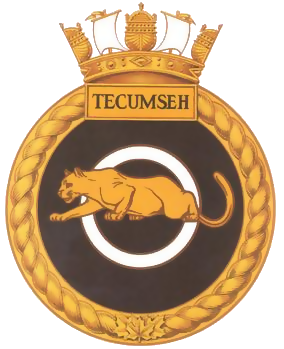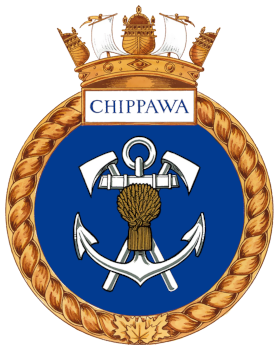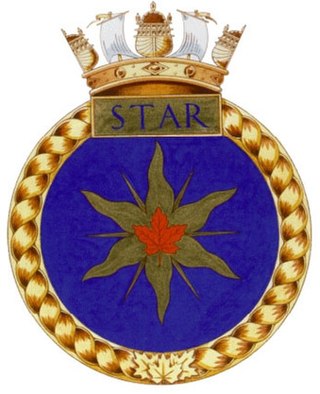
The Royal Canadian Navy is the naval force of Canada. The navy is one of three environmental commands within the Canadian Armed Forces. As of February 2024, the RCN operates 12 Halifax-class frigates, 12 Kingston-class coastal defence vessels, 4 Victoria-class submarines, 4 Harry DeWolf-class offshore patrol vessels, 8 Orca-class patrol vessels, and several auxiliary vessels. The RCN consists of 8,400 Regular Force and 4,100 Primary Reserve sailors, supported by 3,800 civilians. Vice-Admiral Angus Topshee is the commander of the Royal Canadian Navy and chief of the Naval Staff.
The history of the Royal Canadian Navy goes back to 1910, when the naval force was created as the Naval Service of Canada and renamed a year later by King George V. The Royal Canadian Navy (RCN) is one of the three environmental commands of the Canadian Forces. Over the course of its history, the RCN has played a role in the First World War, contributed significantly to the Battle of the Atlantic during the Second World War, and was a part of NATO's force buildup during the Cold War. In 1968, the RCN was amalgamated with the Canadian Army and the Royal Canadian Air Force to form what is today the unified Canadian Armed Forces. The naval force was known as Maritime Command until 2011, when the environmental command was renamed as the Royal Canadian Navy.

HMCS Tecumseh is a Canadian Forces Naval Reserve division (NRD) located in Calgary, Alberta. Dubbed a stone frigate, HMCS Tecumseh is a land-based naval training establishment crewed by part-time sailors and also serves as a local recruitment centre for the Royal Canadian Navy (RCN). It is one of 24 naval reserve divisions located in major cities across Canada.
His Majesty's Canadian Ship (HMCS) Prevost is a Canadian Forces Naval Reserve Division (NRD) located in London, Ontario. Dubbed a stone frigate, HMCS Prevost is a land-based naval establishment for training part-time sailors as well as functioning as a local recruitment centre for the Royal Canadian Navy (RCN). Prevost reserve sailors serve on all classes of ship on both coasts and the Great Lakes and have served on many occasions overseas on UN and NATO tours of duty, along with harbour defence units.

A military reserve force is a military organization whose members (reservists) have military and civilian occupations. They are not normally kept under arms, and their main role is to be available when their military requires additional manpower. Reserve forces are generally considered part of a permanent standing body of armed forces, and allow a nation to reduce its peacetime military expenditures and maintain a force prepared for war. During peacetime, reservists typically serve part-time alongside a civilian job, although most reserve forces have a significant permanent full-time component as well. Reservists may be deployed for weeks or months-long missions during peacetime to support specific operations. During wartime, reservists may be kept in service for months or years at a time, although typically not for as long as active duty soldiers.

HMCS Carleton is a Canadian Forces Naval Reserve Division (NRD) located in Ottawa, Ontario, Canada. Dubbed a stone frigate, HMCS Carleton is a land-based naval training establishment crewed by part-time sailors and also serves as a local recruitment centre for the Canadian Forces Naval Reserve. It is one of 24 naval reserve divisions located in major cities across Canada.

Canadian Forces Base Cornwallis is a former Canadian Forces Base located in Deep Brook, Nova Scotia.

HMCS Chippawa is a Royal Canadian Navy Reserve Division (NRD) located in Winnipeg, Manitoba. Dubbed a stone frigate, HMCS Chippawa is a land-based naval establishment for part-time sailors as well as a local recruitment centre for the Royal Canadian Navy (RCN).

HMCS Star is a Canadian Forces Naval Reserve Division (NRD) located in Hamilton, Ontario. Dubbed a stone frigate, HMCS Star is a land-based naval establishment for training part-time sailors as well as functioning as a local recruitment centre for the Royal Canadian Navy (RCN). The second oldest of 24 naval reserve divisions located in major cities across Canada, Star was stood up on 15 March 1923 as the Royal Canadian Naval Volunteer Reserve (RCNVR) Hamilton Half Company and then on 1 November 1941 as HMCS Star.

HMCS Malahat is a Royal Canadian Navy Reserve Division (NRD) located in Victoria, British Columbia. Dubbed a stone frigate, HMCS Malahat is a land-based naval training establishment for part-time sailors as well as a local recruitment centre for the Canadian Naval Reserve. It is one of 24 naval reserve divisions in major cities across Canada.

The Naval Reserve is the Primary Reserve component of the Royal Canadian Navy (RCN). The primary mission of the NAVRES is to force generate sailors and teams for Canadian Armed Forces (CAF) operations, including: domestic safety operations as well as security and defence missions, while at the same time supporting the Navy's efforts in connecting with Canadians through the maintenance of a broad national presence.

HMCS Unicorn is a Canadian Forces Naval Reserve division (NRD) located in Saskatoon, Saskatchewan. Dubbed a stone frigate, Unicorn is a land-based naval training establishment crewed by part-time sailors and also serves as a local recruitment centre for the Royal Canadian Navy (RCN). It is one of 24 naval reserve divisions located in major cities across Canada.

HMCS Nonsuch is a naval reserve division (NRD) in Edmonton, Alberta. Dubbed a stone frigate, HMCS Nonsuch is a land-based naval establishment for part-time sailors as well as a local recruitment centre for the Canadian Forces Naval Reserve. It is one of 24 naval reserve divisions located in major cities across Canada.

HMCS Hunter is a Canadian Forces Naval Reserve Division (NRD) located in Windsor, Ontario. Dubbed a stone frigate, HMCS Hunter is a land-based naval training establishment crewed by part-time sailors and also serves as a local recruitment centre for the Canadian Forces Naval Reserve. It is one of 24 naval reserve divisions located in major cities across Canada.

HMCS Brunswicker is a Canadian Forces Naval Reserve Division (NRD) located in Saint John, New Brunswick. Dubbed a stone frigate, HMCS Brunswicker is a land-based naval training establishment crewed by part-time sailors and also serves as a local recruitment centre for the Canadian Forces Naval Reserve and the Royal Canadian Navy (RCN). It is one of 24 naval reserve divisions located in major cities across Canada.

HMCS Cabot is a Canadian Forces Naval Reserve Division (NRD) located in St. John's, Newfoundland and Labrador. Dubbed a stone frigate, HMCS Cabot is a land-based naval training establishment crewed by part-time sailors and also serves as a local recruitment centre for the Canadian Forces Naval Reserve. It is one of 24 naval reserve divisions located in major cities across Canada.
HMCS Cataraqui is a Canadian Forces Naval Reserve Division (NRD) located in Kingston, Ontario. Dubbed a stone frigate, HMCS Cataraqui is a land-based naval establishment for part-time sailors as well as a local recruitment centre for the Royal Canadian Navy (RCN). It is one of 24 naval reserve divisions located in major cities across Canada.

HMCS d'Iberville is a Canadian Forces Naval Reserve Division (NRD) located in Rimouski, Quebec. Dubbed a stone frigate, HMCS d'Iberville is a land-based naval establishment for part-time sailors as well as a local recruitment centre for the Royal Canadian Navy (RCN). It is one of 24 naval reserve divisions located in major cities across Canada.
HMCS Griffon is a Royal Canadian Naval Reserve Division (NRD) located in Thunder Bay, Ontario. Dubbed a stone frigate, HMCS Griffon is a land-based naval establishment for part-time sailors as well as a local recruitment centre for the Royal Canadian Naval Reserve. It is one of Royal Canadian Naval Reserve divisions 24 naval reserve divisions located in major cities across Canada.

Navy bands in Canada are part of the Royal Canadian Navy's command structure and overseen by the Music Branch of the Canadian Forces and the Directorate of History and Heritage of the Department of National Defence.
















